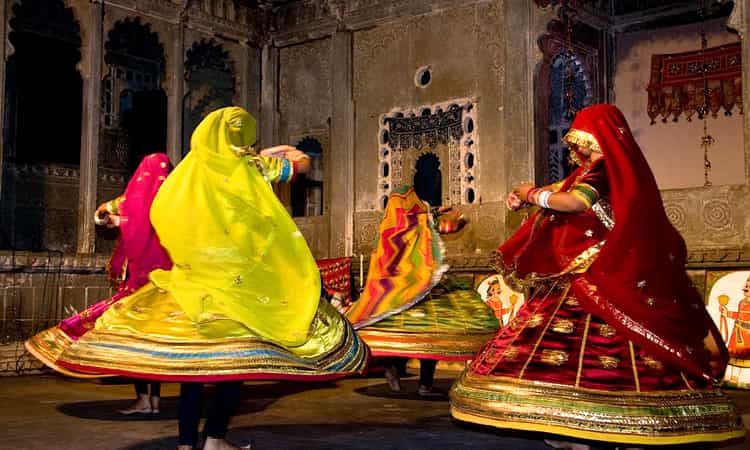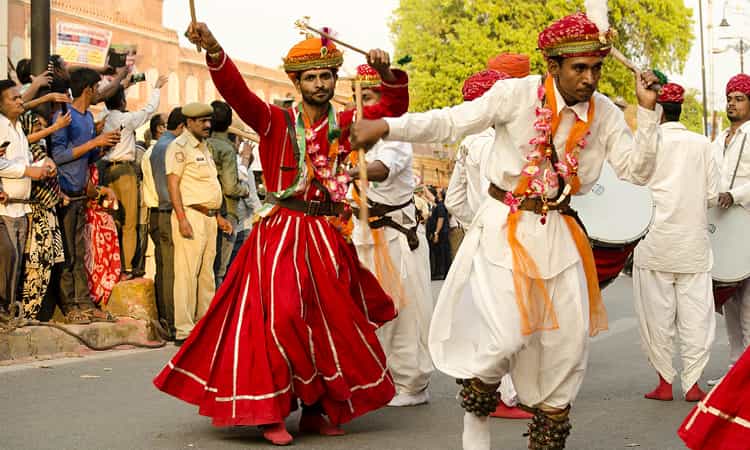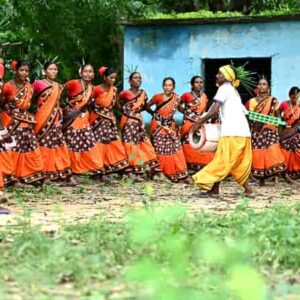Rajasthan, India’s cultural capital and an ‘abode of the rajas,’ boasts its rich heritage. The rich heritage of Rajasthan is reflected through the magnificent monuments, diverse culture, language, enticing art forms, and mind-blowing folk dances. The traditional Rajasthani folk dances are performed during the special events, adding a dash of colors, joy, and happiness to the events. These folk dances are unique, energetic, and vibrant as they narrate the story beautifully, upholding the Rajasthani culture. Each Rajasthani dance form comes with its own history and cultural significance. Read below to learn about the various folk dances of Rajasthan:
List of the 16 Most Famous Folk Dances of Rajasthan:
1. Ghoomar Folk Dance

The Ghoomar folk dance of Rajasthan is a dance of global repute. This dance is performed during the weddings of Rajasthan. Women moving in circles during the dance present a spectacular scene.
2. Gair Folk Dance

This dance is performed during the festival of Holi. Both men and women participate in this dance. During the dance, the performers strike lathis or sticks, moving in a circular pattern and taking brisk turns in between.
3. Bhavai Folk Dance

This is one of the most difficult dance forms in Rajasthan. It can only be done by skilled performers. Women performers take part in this dance. The performers balance about 8 to 9 pitchers on their heads while dancing. Earthen or brass pitchers are used in this unique dance of balance and poise. While balancing the pitchers on the top of their heads, the dancers rest the soles of their feet on the brass thali’s rim, a naked sword’s edge, or the top of a glass. Women of the tribal communities such as Bhil, Jat, Kalbelia, Kumhar, Meena, and Raigar are skilled enough in performing this dance as they have the expertise in carrying several pots atop their heads over long distances across the desert.
Must Read: Folk Dance of Assam
4. Chakri Folk Dance

Women belonging to the Kanjar tribal group perform this dance. The Kanjar tribal group resides mainly in the Hadoti region of Rajasthan. Amazing fast-spinning movements are the chief feature of this dance. The word ‘Chakri’ stands for wheels. As the women dancers swirl and twirl around speedily wearing mirror-work Rajasthani skirts, they resemble the fast-spinning wheels.
5. Chari Folk Dance
This is a dance of the Gujjar ethnic tribe of Rajasthan. Like the Bhavai folk dance, in this dance, women only participate. They carry brass pots on their head while they dance. This dance reflects the everyday life of Rajasthani tribal women. Chari stands for pots. Sometimes, lamps are lit within the pots women carry on their heads.
6. Kalbelia Folk Dance

This dance is performed by the women from the Kalbelia ethnic group of Rajasthan. Dancers wear black skirts or ghagra, and when the dancers spin, that looks exactly like the movement of a serpent. This is why this dance is also called the serpent dance. The dances are themed around mythological tales or folklore.
7. Gawari Folk Dance

This dance is performed exclusively by the men of the Bhil tribe of Rajasthan. Men of the Bhil tribe perform this dance in September and October. This is specifically a dance drama and reflects the love of people for animals, trees, and folklore.
Must Read: Folk Dance of Kerala
8. Terah Taali Folk Dance
Women from the Kamad ethnic group perform the Terah Taali folk dance. The performers sit on the floor with several manjeers tied around their bodies and hit those with the one they carry in their hand.
9. Kachhi Ghodi Folk Dance

The menfolk of Rajasthan perform this dance. The arrangement of the performers in this dance is pretty unique. They place themselves in two rows. Some of the performers make use of a dummy wooden horse kind of costume to mimic the warriors on the battlefield. The performers switch their positions with lots of skill, and it is indeed an enjoyable experience to watch them perform.
10. Kathputli Folk Dance
Rajasthan’s Kathputli folk dance enjoys global fame. It is a puppet-based dance performance that not only entertains the audience but also functions as an eye-opener regarding major social issues. During various festivals, the Kathputli folk dance is staged. A special stage is set up for the Kathputli puppet dance, during which the puppeteer narrates various stories, making his stringed puppets dance to the tune of musical instruments.
11. Chang Folk Dance
This dance is performed in the accompaniment of the Chang instrument. Dancers from the Shekhawati region of Rajasthan are experts in performing this dance. Usually, the male folk participate in this dance form. The dancers dance to the rhythmic beats of the Chang instruments. Interestingly enough, some of the male performers wear the costumes of a woman and dance. The other name for this dance is Dhamal.
12. Fire Dance
Men belonging to Bikaner’s Jasnathis excel in performing this fire dance. Even men from the Churu district of Rajasthan perform the typical fire dance. This dance form is widely practiced during the festivals of Holi and Janmashtami. Various incredible fire tricks are performed during this dance.
13. Dhol Dance
Performers perform this dance to the beats of drum-like instruments such as Dholak, Dhol, Drums, and Nagada. People from Rajasthan’s Jalore region perform this drum dance. The dance picks up pace as the drum beats increase their tempo. The performers occasionally use props like swords while performing this dance. The use of props makes this dance highly enjoyable.
14. Gavari Folk Dance
This dance is performed during the Gavari festival by the Bhil tribal community of Rajasthan. After the end of the Raksha Bandhan festival, the Gavari festival, during which the tribal people move from one place to another performing this folk dance, which is essentially a dance drama. The theme of the dance drama focuses on various mythological tales from the life of Lord Shiva and Goddess Parvati and how they defeated the fierce demon Bhasmasur.
15. Khayal Folk Dance
The word ‘Khayal’ stands for ‘thoughts. This folk-dance drama is based on various characters and stories from Hindu epics like Ramayana and Mahabharata. Menfolk belonging to the Bhavai tribe of Rajasthan perform this folk dance. The skills associated with this dance form are said to run in the family. There is a drama element about this dance. Hence, the performers of this dance form are not only good dancers but also good actors and narrators.
16. Walar Folk Dance
Walar dance is the prototype of the Ghoomar dance form. People of the Garasia tribal community of Rajasthan perform this folk dance. During the festivities of Teej and Gangaur, this particular folk dance is performed. This dance is performed by women performers who move in circular patterns and dance to the beats of musical instruments like Chang or Mandal. Many years back, this dance was performed even within the royal palaces.
Rajasthani folk dances have their origin in the rural customs of Rajasthan. These folk dances make an integral part of the lives of the people of Rajasthan. Many princely states came into being in Rajasthan during the medieval times and added to the growth of the tradition of folk dances, as the rulers of those princely states gave patronage to various art and craft forms, dances being one. In this article, we have talked in detail about the various folk dances of Rajasthan.



